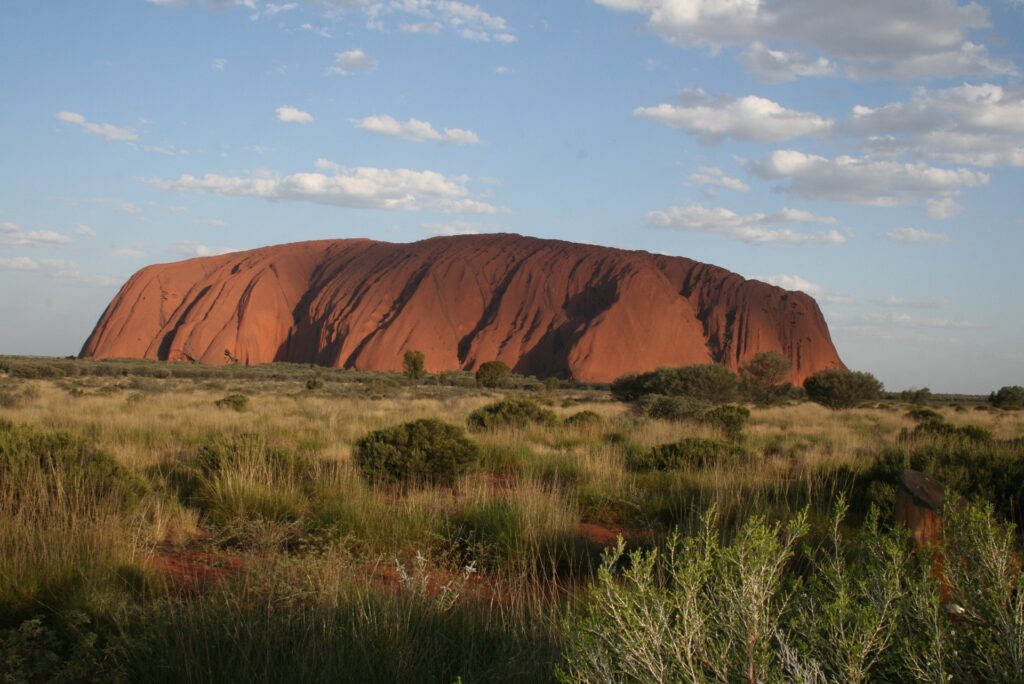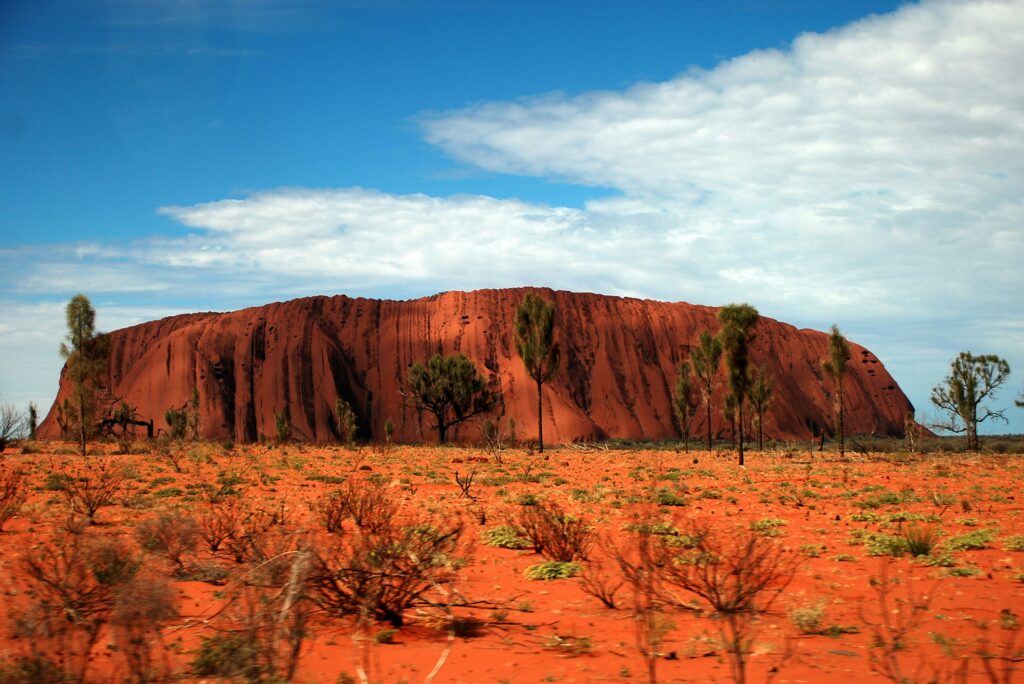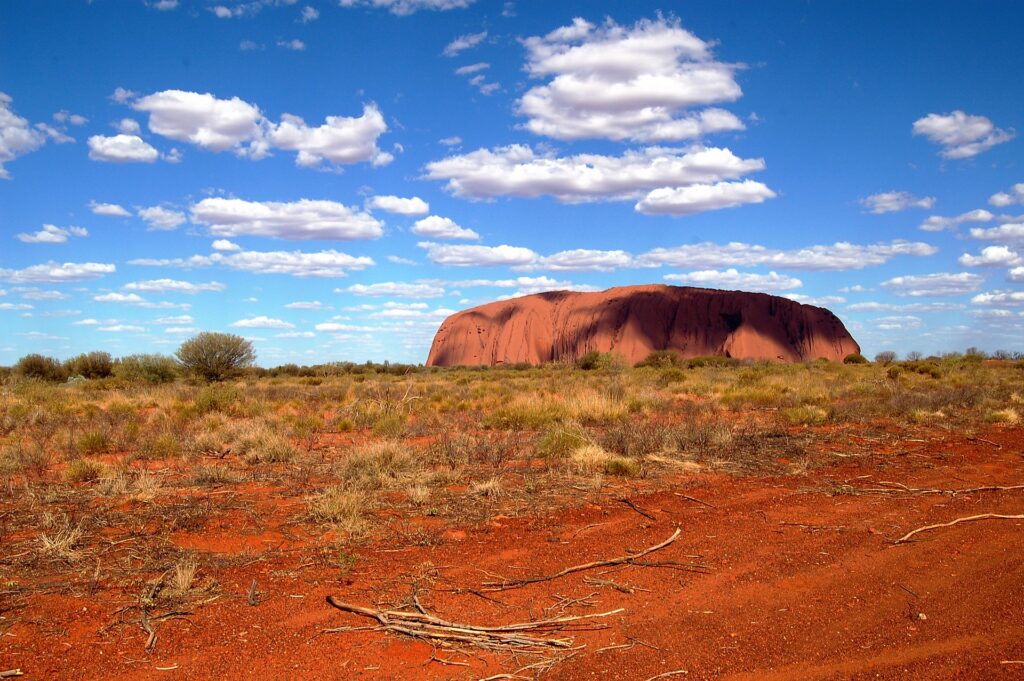Located in the heart of Australia’s arid Red Centre, Uluru, also known as Ayers Rock, stands as a timeless symbol of indigenous culture, natural grandeur, and spiritual significance. This colossal sandstone monolith, rising majestically from the desert landscape, holds a profound mystique that has captivated visitors and Aboriginal custodians for generations. Let us embark on a journey to explore the allure, history, and significance of Uluru as a cultural touchstone and geological wonder of the Australian Outback.

Geological Marvel
Uluru is one of the world’s most iconic natural landmarks, a colossal formation sculpted by the forces of wind and water over millions of years. Rising 348 meters above the surrounding plains and extending deep into the Earth’s crust, Uluru’s sheer size and imposing presence command awe and admiration from all who behold it. The sandstone rock changes hues throughout the day, transitioning from fiery red at sunrise and sunset to deep ochre and purple tones during the day, creating a mesmerizing spectacle that shifts with the light and weather.
You Can Read Our Another Post Mesmerizing Spectacle: The Field of Light Uluru
Geologists believe that Uluru was formed over 500 million years ago, with its layers of sediment gradually compacted and uplifted to create the monolithic structure we see today. The rock’s unique composition, mineral content, and weathering patterns have made it a subject of scientific study and fascination, offering insights into the geological history and processes that have shaped the Australian continent over millennia.
Cultural Significance
For the Indigenous Anangu people, who have lived in the region for over 30,000 years, Uluru holds profound spiritual and cultural significance as a sacred site of creation and ancestral beings. Known as a Tjukurpa or Dreaming site, Uluru is believed to be inhabited by ancient spirits and deities who shaped the land, created the landscape, and laid down the laws and customs that govern human behavior and relationships. The rock’s caves, springs, and crevices are adorned with rock art, petroglyphs, and sacred symbols that tell the stories of the Dreamtime and connect the Anangu people to their heritage and land.

To the Anangu, Uluru is not merely a geological formation but a living entity with a spirit and consciousness of its own. Traditional owners conduct ceremonies, rituals, and dances at the rock to honor and connect with their ancestors, seek guidance and blessings, and maintain the cultural traditions that have been passed down through generations. The rock’s significance as a spiritual center and meeting place underscores its importance as a cultural and historical touchstone for the Indigenous peoples of Australia.
Conservation and Respect
In recognition of Uluru’s cultural and environmental value, the Australian government and traditional owners have worked together to protect and preserve the rock and its surrounding landscape. In 1985, Uluru-Kata Tjuta National Park was established as a UNESCO World Heritage Site, encompassing not only Uluru but also the nearby rock formations of Kata Tjuta (the Olgas) and the rich desert ecosystems that support a diverse array of flora and fauna.

Visitors to Uluru are encouraged to respect the rock’s cultural significance and follow guidelines set out by the Anangu traditional owners, such as refraining from climbing Uluru out of respect for its spiritual importance and environmental impact. Instead, visitors can walk around the base of the rock, explore the surrounding landscape, learn about Indigenous culture and history at the cultural center, and engage in guided tours and activities that promote understanding and appreciation of the rock’s significance.
Tourism and Experience
Despite its remote location in the Australian Outback, Uluru draws thousands of visitors each year who come to marvel at its beauty, learn about its cultural significance, and immerse themselves in the unique landscapes and traditions of the Red Centre. Tour operators offer a range of experiences for travelers, including guided walks, camel rides, helicopter tours, and cultural performances that showcase the history, stories, and customs of the Anangu people.
Sunrise and sunset are particularly magical times to witness Uluru’s transformation as the light plays upon its textured surface, casting shadows and highlighting its contours in a symphony of colors. The night sky above Uluru, free from light pollution, offers unparalleled stargazing opportunities, allowing visitors to marvel at the celestial tapestry that stretches across the outback horizon.
Legacy and Continuity:
As we reflect on the enduring legacy of Uluru as a geological wonder and cultural icon of Australia, we are reminded of the importance of respecting and preserving our natural and cultural heritage for future generations. By honoring the traditions, stories, and custodianship of the Indigenous peoples who have safeguarded Uluru for millennia, we can ensure that this sacred site remains a living connection to the land, the ancestors, and the mysteries of the Dreamtime.
More: Wanted to download Odisha Magazines, visit here

Uluru stands as a testament to the power of nature, the resilience of Indigenous cultures, and the timeless majesty of the Australian Outback. Let us cherish and protect this ancient rock, this sacred symbol, this enduring legacy of the Red Centre, so that its spirit may continue to inspire and enlighten all who journey to its majestic presence.
FAQ For Unveiling the Mystique of Uluru (Ayers Rock)
Where is Uluru located?
Uluru, also known as Ayers Rock, is located in the Northern Territory of Australia, in Uluru-Kata Tjuta National Park.
What is Uluru famous for?
Uluru is famous for its spiritual significance to the Indigenous Anangu people, as well as its striking red sandstone formation that changes color with the shifting sunlight.
What are the best activities to do at Uluru?
Some of the best activities include watching the sunrise or sunset over Uluru, hiking around the base of the rock, attending cultural tours to learn about Indigenous traditions, and stargazing under the clear desert sky.
When is the best time to visit Uluru?
The best time to visit Uluru is during the Australian winter months from May to September when the weather is cooler and more pleasant for outdoor activities.
How do I get to Uluru?
You can fly into Ayers Rock Airport (Yulara Airport) from major Australian cities like Sydney, Melbourne, and Brisbane. Alternatively, you can drive to Uluru from nearby towns like Alice Springs.
Are there accommodation options near Uluru?
Yes, there are various accommodation options near Uluru, including luxury resorts, camping grounds, and budget-friendly hotels in Yulara and the surrounding area.
Is climbing Uluru allowed?
Climbing Uluru is culturally insensitive and has been discouraged by the local Anangu people due to its spiritual significance. As of 2019, climbing Uluru is prohibited.
Are there guided tours available at Uluru?
Yes, there are guided tours available that offer insights into the cultural significance of Uluru, as well as opportunities to explore the surrounding landscape and learn about the flora and fauna of the region.
What should I pack for a trip to Uluru?
Don’t forget to pack sunscreen, a hat, comfortable walking shoes, plenty of water, a camera, and appropriate clothing for both hot days and cool nights in the desert.
Can I see the Field of Light art installation at Uluru?
Yes, the Field of Light art installation by Bruce Munro is a mesmerizing display of thousands of illuminated stems that light up the desert floor at night. It is a must-see when visiting Uluru.

